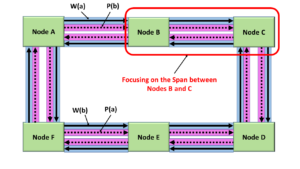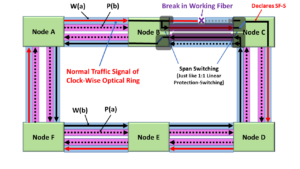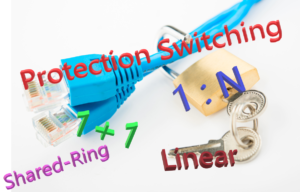What is Span-Switching within a Shared-Ring Protection-Switching System?
A 4-Fibre/4-Lambda Shared-Ring Protection-Switching system will support the two types of Protection-Switching.
- Span-Switching and
- Ring-Switching
NOTE: A 2-Fibre/2-Lambda Shared-Ring Protection-Switching system will NOT support Span-Switching. It will only support Ring-Switching.
Span-Switching is a Protection-Switching scheme that only involves a single-Span.
Example of Span-Switching
The best way to describe Span-Switching is to show an example of how it works.
Let’s suppose that we are using a 4-Fibre/4-Lambda Shared-Ring Protection-Switching system. Additionally, I will focus on the Span between Nodes B and C in this case.
Therefore, in Figure 1, I highlight a 4-Fibre/4-Lambda Shared-Ring Protection-Switching system with the span between Nodes B and C.

Figure 1, Illustration of a 4-Fibre/4-Lambda Shared-Ring Protection-Switching system, with the span (between Nodes B and C) highlighted.
If you look closely at the span between Nodes B and C, you will notice that this span contains the following four optical signals.
- The Clockwise Optical Signal – Working Transport entity (the blue-shaded fiber – with the signal passing through it in the clockwise direction),
- The Clockwise Optical Signal – Protection Transport entity (the pink-shaded fiber – with the signal moving through it in the clockwise direction),
- The Counter-Clockwise Optical Signal – Working Transport entity (the blue-shaded fiber – with the signal passing through it in the counter-clockwise direction),
- The Counter-Clockwise Optical Signal – Protection Transport entity (the pink shaded fiber – with the signal passing through it in the counter-clockwise direction).
Now that we’ve introduced our 4-Fibre/4-Lambda Shared-Ring Protection-Switching system, let’s see some protection-switching.
A Defect in the Fiber
Let’s further assume that we are experiencing a service-affecting defect within the Clockwise-Direction Working Transport entity fiber, as I show below in Figure 2.

Figure 2, Illustration of a Service-Affecting Defect within the Clockwise Direction Working Transport entity fiber (between Nodes B and C)
Whenever this service-affecting defect occurs (within the Span between Nodes B and C), Node C will declare the SF-S (Signal Fail – Span) defect condition. Node C will respond to this SF-S defect condition by issuing a Span-Switching request between it and Node B.
Clueless about OTN? We Can Help!!! Click on the Banner Below to Learn More!!
Corporate Discounts Available!!!
Implementing Span-Switching
Nodes B and C will exchange information with each other via a communications protocol (that we called the Shared-Ring Protection-Switching system APS/PCC protocol).
After Nodes B and C have completed this exchange of information (via the APS/PCC protocol), each of these nodes will have executed some protection-switching, such that both Nodes will now be exchanging regular ODUk traffic via the Protection Transport entities (in both directions), rather than using the Defective Working Transport entity (in the Clockwise Direction).
I show the results of this Protection-Switching effort below in Figure 3.

Figure 3, Illustration of Span-Switching, between Nodes B and C
Span-Switching works (in this scenario) because we can use the Protection-Transport entity fiber. This Protection Transport entity fiber carries traffic in the same direction as the broken Working Transport entity (within the Span, going from Nodes B to C).
Therefore, we can use it to bypass the defect within the Working Transport entity fiber.
NOTE: All Shared-Ring Protection-Switching will use a 1:1 Protection-Switching Architecture.
Why is this Span-Switching Bidirectional?
Question:
Our 4-Fibre/4-Lambda Shared-Ring Protection-Switching system experienced a single Service-Affecting Defect (within the Working Transport entity of the Clockwise Optical Loop).
Why did we perform Span-Switching in both directions (even for the Counter-Clockwise Optical Loops)?
Answer:
ITU-T G.808.2 states that all Shared-Ring Protection-Switching MUST be Bidirectional.
Therefore, if we are required to perform protection-switching in one direction (to avert a defect condition), we must also complete a similar protection switch in the opposite direction – to make it bidirectional.
Can the User Implement Span-Switching at other locations in the Shared-Ring Protection-Switching System?
In a word, Yes.
In our example, Nodes B and C only use the Protection-Transport entity resources between these two nodes. We have not taken up any other Protection-Transport entity resources along any remaining spans within the ring.
Therefore, the user can have multiple instances of Span-Switching within a Single Ring.
Has Inflation got You Down? Our Price Discounts Can Help You Beat Inflation and Help You Become an Expert on OTN!! Click on the Banner Below to Learn More!!
Discounts Available for a Short Time!!
Click on the Image Below to see more Protection-Switching related content on this Blog:




